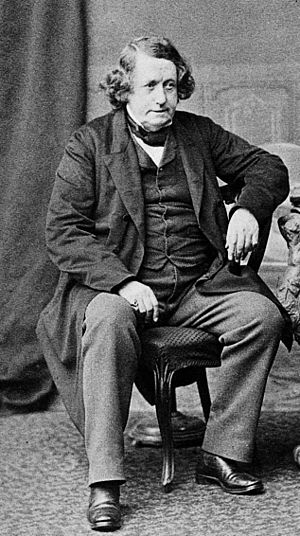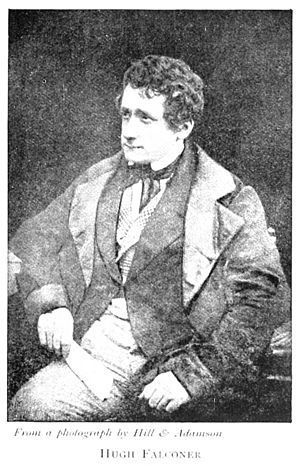Hugh Falconer facts for kids
Quick facts for kids
Hugh Falconer
MD, FRS
|
|
|---|---|
 |
|
| Born | 29 February 1808 Forres, Scotland
|
| Died | 31 January 1865 (aged 56) London, England
|
| Alma mater | University of Aberdeen University of Edinburgh |
| Known for | Precursor of punctuated equilibrium |
| Parent(s) |
|
| Awards | Wollaston Medal 1837 |
| Scientific career | |
| Fields | Geology, Botany, Paleontology |
| Institutions | Saharanpur Botanical Gardens Calcutta Medical College Agric. Hort. Soc. Bengal |
| Doctoral advisor | Robert Jameson |
| Author abbrev. (botany) | Falc. |
Hugh Falconer (born February 29, 1808 – died January 31, 1865) was a Scottish scientist. He was a geologist, who studies Earth's rocks and history. He was also a botanist, who studies plants, and a palaeontologist, who studies fossils.
Falconer explored the plants, animals, and rocks of India, Assam, Burma, and many Mediterranean islands. He was one of the first to suggest an idea similar to punctuated equilibrium. This is a modern theory about how species change over time. He also studied ancient fossil beds in the Sivalik Hills and might have been the first to find a fossil ape.
Contents
Early Life and Studies
Hugh Falconer was born in Forres, Scotland. He was the youngest son of David Falconer. In 1826, he finished his studies at the University of Aberdeen. There he focused on natural history, which is the study of living things.
Later, he studied medicine at the University of Edinburgh. He earned his medical degree in 1829. During this time, he was very interested in botany (plants) and geology (rocks). His geology teacher was Robert Jameson, who also taught Charles Darwin.
In 1830, Falconer became an assistant-surgeon. He worked for the British East India Company in Bengal, India. When he arrived, he studied fossil bones from Burma. His descriptions of these fossils made him a respected scientist in India. In 1831, he was sent to the army base at Meerut.
Discoveries in the Siwalik Hills
In 1832, Falconer became the boss of the Saharanpur botanical garden in India. He stayed there for ten years. During this time, he became famous for studying fossil mammals in the Sivalik Hills.
In the 1830s, Falconer and his team found what might be the first fossil ape. They found it in ancient rock layers in the Siwalik Hills. In 1831, Falconer also found bones of crocodiles, tortoises, and other animals.
He and his colleagues discovered many ancient animals. These included huge Mastodons, the giant ruminant Sivatherium, and the enormous extinct tortoise Colossochelys atlas. Falconer also wrote about the geology of the Siwalik Hills in 1834. For these important finds, he and Proby Cautley won the Wollaston Medal in 1837. This is the highest award from the Geological Society of London.
In 1834, Falconer was asked to check if tea could be grown for business in India. He said yes, and tea plants were brought in. The black tea grown there became very popular.
Falconer returned from India in 1842 because he was not well. He brought back many boxes of dried plants and fossils. He then traveled around Europe, studying geology. In 1845, he became a member of the Royal Society. He continued to work for the British East India Company. He studied fossils at the British Museum and made copies of important fossils for other museums.
Work in Calcutta
In 1847, Falconer became the head of the Indian Botanical Gardens in Calcutta. He also became a professor of botany at the Calcutta Medical College. His older brother, Alexander, was a merchant in Calcutta.
Hugh Falconer advised the Indian government on farming. He wrote an important report about teak forests. This report helped save the forests from being cut down too much. He also suggested growing cinchona plants in India. The bark of these plants is used to make medicine for malaria.
Ideas on Evolution
At first, Falconer believed in Creationism. This is the idea that species were created and do not change. In 1859, Charles Darwin sent Falconer a copy of his book, On the Origin of Species. Darwin wrote that he thought Falconer would eventually believe that species do change.
By the early 1860s, Falconer changed his mind. He started to believe in evolution after studying many fossils.
In 1863, Falconer wrote about an ancient elephant from North America. A year before, he had sent his work to Darwin, who loved it. In his work, Falconer noticed something important. He saw that fossil mammals often stayed the same for long periods. Then, they would change very quickly in short bursts.
This idea was very advanced for his time. A century later, scientists Niles Eldredge and Stephen Jay Gould developed a similar theory. They called it punctuated equilibrium. Gould said that Falconer's work showed that when a new species appears suddenly in one place, it might have come from an older group living somewhere else. Then, it moved into the new area.
Later Years and Legacy
Falconer had to leave India again in 1855 due to poor health. He spent the rest of his life in England and Europe. He compared the fossils he found in India with others. He studied ancient mastodons, elephants, and rhinoceroses. He also found new mammals in the Purbeck Group of rocks in England.
He also looked into human origins. He explored bone caves in places like Sicily, Malta, and Gibraltar. In Sicily and Malta, he discovered a dwarf elephant species called Palaeoloxodon falconeri. He also found bones of a giant flightless swan, Cygnus falconeri, in Malta.
Falconer was a vice-president of the Royal Society from 1863 to 1864. He worked very hard and got sick. But he quickly returned from Gibraltar to help Charles Darwin win the Copley Medal in 1864. Hugh Falconer died in London on January 31, 1865, from heart and lung problems. He is buried in Kensal Green Cemetery.
The beautiful flower Rhododendron falconeri was named after him by Joseph Dalton Hooker.
Falconer's notes on plants, with 450 colorful drawings, are kept at Kew Gardens. A marble statue of him is in the Royal Society in London and another in the Asiatic Society of Bengal in Calcutta. A special scholarship was created in his name for science or medicine students at the University of Edinburgh.
The Falconer Museum in Forres, Scotland, tells the story of Hugh Falconer. It also shares stories about local and Scottish history.
Selected Publications
- Hugh Falconer and Proby T. Cautley, Fauna Antiqua Sivalensis (1846): This book describes the fossil animals from the Siwalik Hills in India.
- On the American Fossil Elephant (1863): This work discusses ancient elephants found near the Gulf of Mexico.
- Palæontological memoirs and notes of the late Hugh Falconer (1868): This two-volume collection of his writings was put together after he passed away.


